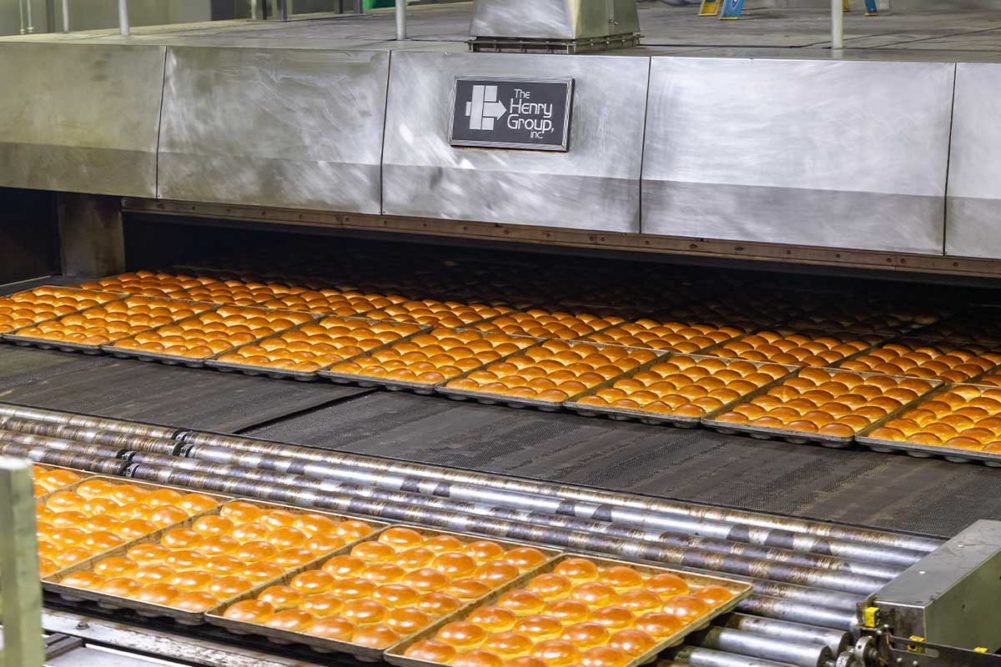Rotella’s Italian Bakery, La Vista, Neb., hasn’t stopped investing in the business. Its latest expansion was made in 2018 and added 60,000 square feet of production space in the company’s South bakery. Within that, the company installed a new bun and roll line and its fourth tunnel oven in that facility to provide much-needed extra capacity.
This newest addition is fed by two 150,000-lb Shick Esteve silos. Major and liquid ingredient handling is automated by the Shick Esteve ingredient handling system into two 1,600-lb Shaffer mixers. On this production line, minors are still hand-scaled, though Rotella’s has automated that process in other areas of the facility. Despite being able to handle 1,600-lb batches, the dough batches on the day Baking & Snack visited were 1,400 lbs of brioche bun dough, which were emptied into troughs and automatically hoisted into one of three rebuilt Adamatic roll lines.
The company decided to rebuild its Adamatic makeup lines to mimic what was already being done in other parts of the facility. This made startup and training on the new line fairly seamless. Investments that represent products new to the Rotellas have required more attention.
“If we’re getting into something new, like when we got into ciabatta, there was a big learning curve,” said John Rotella, general manager. “With gluten-free, that’s when I lost all my hair.”
The dough batch is chunked and divided in an eight-pocket divider. Dough pieces are rounded and spaced to be panned. The roll lines have the capabilities to sheet and incorporate an intermediate proof to make hoagies as well. However, the line mostly focuses on hamburger buns and sliders, while that flexibility exists if needed in the future.
Once product is panned, it travels upwards on the conveyor to the tray-style proofer from The Henry Group that sits on the mezzanine floor above the tunnel oven.
“We decided to do an overhead proof box with the oven underneath to use the space more efficiently,” John Rotella explained.
With this type of proofer, the bakery also gained more flexibility even though it required more maintenance expertise. The proofer can handle a variety of pans and can be adjusted to suit the product’s needs.
After a 45-minute proof, pans travel by conveyor back down to the ground floor to be scored or have toppings added by the Burford robotic scoring unit and glazer. Pans then enter the 120-foot-long indirect gas-fired tunnel oven from The Henry Group for a 12- to 15-minute bake time. After depanning, the products travel up again to a second floor to cool on an I.J. White spiral cooler while pans travel on an overhead conveyor to be cooled before being stacked by a Stewart Systems stacker/unstacker.
The cooler room is kept between 70° and 75°F and held steady throughout the year regardless of weather. Signs on the cooler room door reinforce that the room should be kept closed at all times.
“You don’t want to keep it too cold or else you’ll get condensation on the buns,” John Rotella explained.
Once the buns are cooled, they travel into the large packaging room that supports all four ovens in the South bakery. Only three of these bagging lines handle packaging for the new bun and roll line, but the department houses 14 packaging lines in total: 11 roll lines, two bread lines and one bulk packer.
Cooled buns are dispersed between three Bettendorf Stanford slicers and bagger lines. Once the buns are sliced, they are oriented into the proper configuration for the bagger, packaged and then sealed by a Kwik Lok closure. Fortress Technology metal detectors check the product for foreign materials before the bags are manually packed into boxes emblazoned with the Rotella’s logo.
This article is an excerpt from the February 2023 issue of Baking & Snack. To read the entire feature on Rotella's Italian Bakery, click here.





